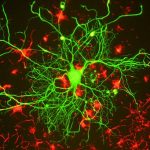As winter draws closer and the days grow shorter, it seems like the perfect time to brew a hot cup of tea, curl up by the fire, and complain bitterly about that 4:30 sunset. Unfortunately for some, that early sunset can become more that just a bummer and can result in a form of depression known as Seasonal Affective Disorder, aptly abbreviated as SAD.(a) In an effort to better understand disorders like SAD, a recent paper in Nature attempts to look more deeply into the role light can play in depression and other facets of psychological well-being.1
In this study, a group of scientists led by Samer Hattar at Johns Hopkins University started by altering the patterns of light exposure for their laboratory mice. Generally, mice are on a 12 hour light/dark cycle, but in this experiment, the mice were exposed to periods of alternating light and dark lasting only 3.5 hours. The goal of the experiment was to determine the role of light itself, in isolation from other physiological factors, so the researchers first had to confirm that the shorter light/dark cycle was not influencing other light-related behaviors like sleep or circadian rhythms.(b)
Having confirmed that these behaviors were unchanged, the researchers went on to see if there were other alterations in brain chemistry. One of the key changes they observed was an increase in corticosterone, an important stress hormone that can cause depression-like symptoms in rodents. Along with increased stress hormones, the animals exposed to the aberrant light cycle scored higher on a number of tests designed to measure depression-like symptoms in mice.(c) Additionally, these animals were slower at a learning task that involved locating a hidden platform over successive days. This learning defect was confirmed at the neurological level by tests that showed changes in long-term potentiation, the cellular process that underlies memory and learning.
At this point the researchers had found plenty of bad news for mice – and, by extension, humans – who are subjected to abnormal cycles of light and dark. However, their next round of experiments provided some cause for hope. The mice were given the anti-depressant fluoxetine (Prozac), which seemed to reverse many of the symptoms associated with the altered light cycle.
These experiments provide some key insights into how light can affect mood and learning, but as always, there are caveats. For one thing, the changes in light exposure for the experimental mice were much more abrupt and extreme than those experienced by humans during the changing seasons. Additionally, although the light cycles were altered, the overall amount of light experienced by the mice was basically unchanged. Although this work does show that light can have a direct impact on brain chemistry, it does not address how the subtler changes in light/dark cycles that come along with the changing seasons might influence depression, learning, or brain chemistry. Hopefully, future experiments will more directly address how seasonal light changes can affect the human brain and will give us some clues as to how best to offset these effects when the long dark winter rolls around.
Endnotes
- Tara A. LeGates, Cara M. Altimus, Hui Wang, Hey-Kyoung Lee, Sunggu Yang, Haiqing Zhao, Alfredo Kirkwood, E. Todd Weber, and Samer Hattar (2012) “Aberrant light directly impairs mood and learning through melanopsin-expressing neurons,” Nature, 491: 594–598.
Sidenotes
- (a) SAD affects up to 10% of the population depending on latitude. Common treatments include standard anti-depressants and light therapy.
- (b) Circadian rhythms are biological changes in an organism that cycle approximately every 24 hours. While they tend to coincide with light/dark cycles, and can be altered by changes in light exposure over time, there are also internal molecular clocks that control circadian rhythms somewhat independently of light.
- (c) One metric used was, “behavioral despair in a forced swim test,” which sounds rather depressing indeed.





